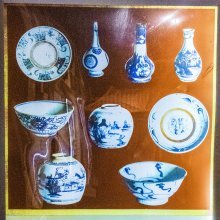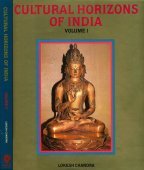Tang, Taṅg: 7 definitions
Introduction:
Tang means something in Hinduism, Sanskrit, Hindi, biology. If you want to know the exact meaning, history, etymology or English translation of this term then check out the descriptions on this page. Add your comment or reference to a book if you want to contribute to this summary article.
Images (photo gallery)
Biology (plants and animals)
Source: Wisdom Library: Local Names of Plants and DrugsTang [ٹنگ] in the Kashmiri language is the name of a plant identified with Pyrus communis L. from the Rosaceae (Rose) family. For the possible medicinal usage of tang, you can check this page for potential sources and references, although be aware that any some or none of the side-effects may not be mentioned here, wether they be harmful or beneficial to health.

This sections includes definitions from the five kingdoms of living things: Animals, Plants, Fungi, Protists and Monera. It will include both the official binomial nomenclature (scientific names usually in Latin) as well as regional spellings and variants.
Languages of India and abroad
Sanskrit dictionary
Source: DDSA: The practical Sanskrit-English dictionaryTaṅg (तङ्ग्).—1 P. (taṅgati, taṅgita)
1) To go, move.
2) To shake, tremble.
3) To stumble.
Source: Cologne Digital Sanskrit Dictionaries: Benfey Sanskrit-English DictionaryTaṅg (तङ्ग्).—i. 1, [Parasmaipada.] 1. To go. 2. To stumble. 3. To shake.
Source: Cologne Digital Sanskrit Dictionaries: Monier-Williams Sanskrit-English DictionaryTaṅg (तङ्ग्):—[class] 1. [Parasmaipada], gati, to go, [Dhātupāṭha v, 41];
—to stumble, [ib.];
—to tremble, [ib.]
[Sanskrit to German]
Sanskrit, also spelled संस्कृतम् (saṃskṛtam), is an ancient language of India commonly seen as the grandmother of the Indo-European language family (even English!). Closely allied with Prakrit and Pali, Sanskrit is more exhaustive in both grammar and terms and has the most extensive collection of literature in the world, greatly surpassing its sister-languages Greek and Latin.
Hindi dictionary
Source: DDSA: A practical Hindi-English dictionaryTang in Hindi refers in English to:—(a) narrow; scarce; troubled; harassed; girth, belt of a horse; ~[dasta] short of money, scarcity-stricken; ~[dasti] state of penury, scarcity of money, poverty; ~[dila] hide-bound, small hearted; hence ~[dili] (nf); ~[hala] tight, distressed, in great straits; ~[hali] narrow circumstances, straits, tightness; —[ana] to be tired (of), to be fed up; to be browned off; —[karana] to trouble, to harass, to victimize..—tang (तंग) is alternatively transliterated as Taṃga.
...
See also (Relevant definitions)
Starts with (+139): Taanginu, Tamgadale, Tamgadir, Tamgadira, Tamgadiradaleya, Tamgadirvakki, Tamgadirvatta, Tamgai, Tamgal, Tamgalanna, Tamgali, Tamgallu, Tamgalu, Tamgalutatva, Tamgalutatvajnana, Tamgane, Tamgara, Tamgaraga, Tamgavala, Tamge.
Ends with (+53): Atang, Bantang, Bap-kang-tang, Bartang, Brojo lintang, Bunga petang, Caay mafng tang, Calamus rotang, Chas tang, Chastang, Chatang, Chong chi qiu hai tang, Cu hui qiu hai tang, Da wang qiu hai tang, Daun katang, Er tuo qiu hai tang, Etang, Ettang, Ginda purang utang, Gyelangtang.
Full-text (+99): Huang hai tang, Tang ta bot, Lang-tang-chang, Shi li tang song cao, Gou zhu tang song cao, Ya ou tang song cao, Chas tang, Yi tang, Lang tang, Tang-nap, Tang ti, Tang-antang, Tang-vong, I tang, Bai tang zi zhu, Tang cha biao zi, Tang-rakwenga, Tang- rambrezounga, Tang-shen, Tang-nang.
Relevant text
Search found 27 books and stories containing Tang, Taang, Taṅg; (plurals include: Tangs, Taangs, Taṅgs). You can also click to the full overview containing English textual excerpts. Below are direct links for the most relevant articles:
Buddha-nature (as Depicted in the Lankavatara-sutra) (by Nguyen Dac Sy)
Introduction to Chinese Buddhism < [Chapter 6 - Further Development of the Thought of Buddha-nature in China]
The Concept of Buddha-nature < [Introduction]
Introduction to the Laṅkāvatāra-sūtra < [Introduction]
The Fo-Sho-Hing-Tsan-King (A Life of Buddha) (by Samuel Beal)
Lives of Buddha (10): Fang-kwang-tai-cwang-yan-king < [Introduction]
Sūtra of the Great Vow of Kṣitigarbha Bodhisattva
Reverberations of Dharmakirti’s Philosophy (by Birgit Kellner)
Participants of the Fifth International Dharmakīrti Conference
The Great Buddhist Emperors of Asia (by Shibani Dutta)
Chapter 5 - Korean Emperor Wang Kiyen (918 A.C.–949 A.C.)
Chapter 3 - King Sron Tsan Gampo of Tibet (617 A.C.–698 A.C.)
Maha Prajnaparamita Sastra (by Gelongma Karma Migme Chödrön)
Appendix 2 - The offering of the future Śākyamuni to the Buddha Dīpaṃkara < [Chapter VIII - The Bodhisattvas]
2. Actions producing the thirty-two marks (dvātriṃśallakṣaṇa) < [Part 4 - The Bodhisattva in the Abhidharma system]
Act 6: The Buddha manifests his supernatural qualities in the trichiliocosm < [Chapter XIV - Emission of rays]
Related products

